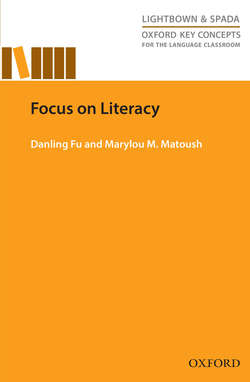Читать книгу Focus on Literacy - Danling Fu - Страница 6
На сайте Литреса книга снята с продажи.
Introduction
ОглавлениеThis book is about second language biliteracy development in a globalized, transnational world viewed from a sociocultural and sociolinguistic perspective. It is written primarily for teachers and future teachers of children and adolescents who are developing literacy in second or foreign language classrooms. Angel Lin and her colleagues (Lin et al., 2011) indicate that social perspectives on biliteracy development require a paradigm shift from thinking about teaching English as a second language (ESL) to thinking about teaching English communication in the 21st century globalized, transnational world. In such a world, students must learn to reconcile identities rooted in local language and literacies with multiple practices and perspectives. At the same time, they are developing and maintaining transnational identities as they intentionally participate in multiple communities, beyond and without regard for national borders.
While first-language (L1) literacy teaching and learning have been studied extensively, there are far fewer studies of second-language (L2) literacy (Dorwin & Moll, 2006). Overlapping results suggest that much, but not all, of what we know to be good L1-literacy teaching applies to L2-literacy teaching as well. However, we must modify instruction to accommodate varied sociocultural and sociolinguistic perspectives as well as language development, and conceptual growth of L2 learners (Escamilla, 2009). We believe that this requires teachers to be inquirers, striving to become life-long learners and informed decision makers, for, as Johnson (2006) points out: honing the intellectual tools of inquiry, reflection, and analytic processes helps empower and transform professional identities. As we hope to demonstrate in this book, empowering yourselves with more knowledge about social perspectives on biliteracy development will enable you to prepare your students to effectively engage in literacy practices in the multilingual and increasingly transnational environments in which they live and learn.
This volume is grounded with the framework of languaging-as-thinking and communicative competence within multiliteracies– a complex combination of multiple modes, multiple languages, multiple platforms (means of delivery), multiple sign-systems, and multiple perspectives in multiple social contexts (New London Group, 1996). As such, it emphasizes the strong learning support of literacy scaffolds– the support provided by actual reading and writing activities – as well as supports in the form of guidance, strategies, inquiry, and resources that enable learners to move fluently and intentionally among the multiple modes of communication embedded in transnational, multimodal texts (Boyle & Peregoy, 1990). The volume is organized to promote metacognitive awareness, analytic inquiry, and a responsive, reflective stance on the part of teachers who seek to empower L2 learners as they encounter the rapid changes of the 21st century. Our goal is to provide teachers with accessible, relevant, and succinct information on background research and classroom-based research.
Throughout the book, you will find Classroom Snapshots – vignettes taken from elementary and secondary school classrooms, as well as Spotlight Studies – for you to examine as reflective practitioners and to consider as ‘discerning consumers’ (Perry, 2011). In each chapter, we will also ask you to participate in activities that promote first-hand experiences leading to metacognitive understandings of literacy learning strategies. By taking you through these processes, we will be presenting an overview of second-language literacy instruction while demonstrating how teachers can go about interpreting evidence from research and other resources, including their own experiences with literacy teaching and learning, to facilitate informed planning appropriate for students in an ever-changing, transnational world.
Chapter 1 presents the theoretical framework of the book, a languaging-as-thinking perspective based upon the active construction of language. It invites readers to explore their ideas on topics pertaining to L2-literacy instruction for 21st-century empowerment. In this chapter, we define and examine linguistic competence and communicative competence as they pertain to 21st-century language and literacy instruction and the intentional design of text. Chapter 2 reviews research on key topics pertaining to L2-literacy instruction for a transnational world, including learners and learning contexts, the importance of recognizing local literacies, transnational identities, and inquiry into multiliteracies.
Chapter 3 links research with classroom practice grounded in the languaging-as-thinking perspective for young L2-literacy learners (grade 6). Chapter 4 adopts the same structure for L2 learners at the secondary-school level. It specifically addresses the challenges of literacy instruction for L2 adolescents and illustrates how schools and teachers meet those challenges. Chapter 5 concludes the book by asking readers to re-examine their views of literacy learning and invites them to reposition themselves as informed, reflective decision-makers in order to meet the diverse needs of L2-literacy learners who are actively developing empowered transnational identities.
This book is not going to provide a step-by-step method for integrating a languaging-as-thinking perspective into instruction. It is meant, instead, to help empower teachers to make informed instructional decisions. Educators implement hundreds of instructional decisions each day. Some are carefully planned well in advance and some are designed on the spot in response to immediate teachable moments or instructional challenges. We hope to encourage teachers and future teachers to use this text as a springboard for the exploration of their own ideas about literacy instruction and to further develop their own professional stance.
